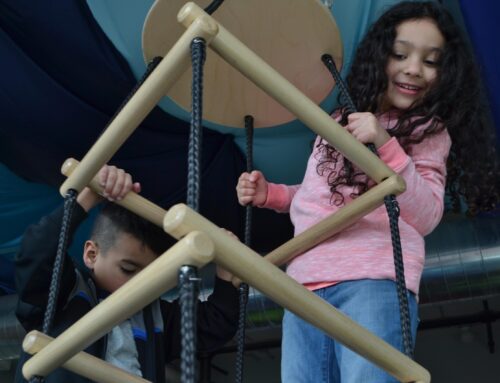You may have heard of babies skipping their crawling milestone. You may also have heard that crawling is no longer on the developmental checklist. Perhaps you are wondering why crawling is such a big deal and why it can’t be skipped. This blog will help you understand the importance of crawling as a foundational skill for gross motor development and why we at Blue Bird include it in our curriculum, even though it is a skill that is typically seen at 8-to-11 months of age.
Crawling is another form of tummy time!
Your pediatrician probably recommended that your child perform tummy time as an infant. Tummy time promotes the strength and development of the muscles behind the neck and along the spine. Similarly, crawling is a great way to strengthen those muscles, especially the muscles behind the neck. It helps your child practice maintaining head control while the rest of their body is moving. At Blue Bird Day, we use crawling to promote head control and strengthening of those spinal muscles.
Crawling promotes scapular strengthening and shoulder stabilization.
What does this mean? Think about doing a pushup. When you put weight through your hands, the muscles in your shoulder, around your shoulder blade, and in your upper back have to work to prevent your upper body from collapsing to the ground. As infants, crawling is one of the first ways they are exposed to strengthening of the muscles in their shoulders and upper back. They miss out on a lot of opportunities for upper body strengthening when they do not crawl. How does this apply to our clients at Blue Bird? If our kiddos have weaker shoulders or upper bodies, crawling is a great way to promote the development of those muscles.

Crawling encourages upper and lower extremity dissociation.
In simple terms, it means that crawling helps separate the movements of arms and legs and increases the flexibility of the spine. When a baby crawls, arms and legs should move in opposite directions. For example, when the right arm moves forward, the right leg will simultaneously be moving back. As this happens, it will cause the spine to bend to the left, and vice versa for when the left arm is moving forward. This repetitive action that is associated with crawling helps increase the flexibility of the spine since it is constantly being moved side-to-side. Our clients at Blue Bird can benefit from crawling because they work on moving their arms and legs separately!
Crawling can help with walking!
The movement patterns of crawling imitate that of walking. How so? Weight-bearing and elongation. Let’s return to the example in the previous paragraph. When a baby’s right hand is moving forward, its right leg is moving back and the left leg is in the air. That means that 1) the right side of the body is elongating, and 2) the baby’s weight is on the right leg. This pattern is also repeated on the opposite side of the body. Now let’s take a look at walking. It is very subtle, but when you put weight through your right leg, the right side of your body should elongate more than it should collapse. Thus, crawling is one of the first movements where a baby learns this elongation pattern and can be considered a foundational skill for walking.
As you can see, crawling has many benefits for different parts of the body and plays a role in the development of gross motor skills. Our goal as therapists at Blue Bird is not only to ensure that our clients’ higher–level targets are met, but also that they have strong foundational skills that will set them up for success. There are many foundational skills needed for the development of efficient gross motor milestones, and crawling is no exception.

Blue Bird Day fosters socialization, sensory regulation, and pre-academic learning in children ages 2-7 years in therapeutic rotations that simulate preschool and kindergarten settings. Our compassionate therapists practice a relationship-based and family-centered approach, provide parent training, and collaborate on goals and individualized intensive treatment plans for your child.
We believe in a collaborative and multi-disciplinary team approach to therapy. A team of occupational therapists, speech-language pathologists, dietitians, developmental therapists, behavioral therapists, physical therapists, and therapeutic assistants are created for each child to ensure child and family are fully supported and the best possible results are achieved.
Options for individualized, group and virtual therapy sessions are available as well.
Want to learn more or you have a specific question? Feel free to connect with us here!



